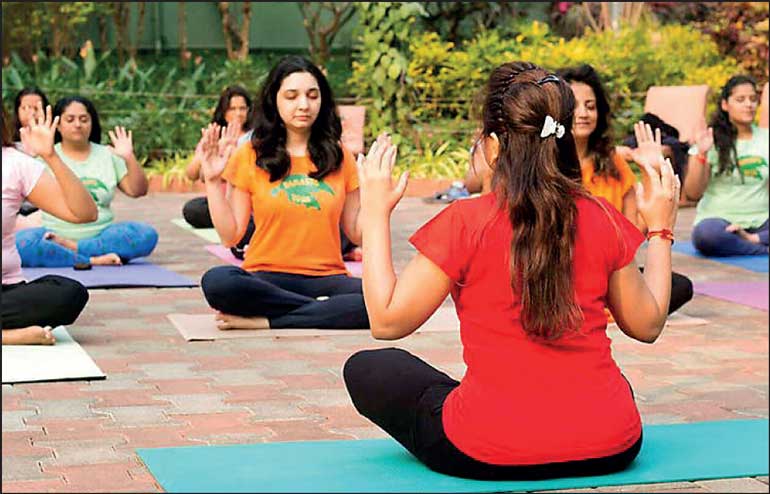Wednesday Dec 31, 2025
Wednesday Dec 31, 2025
Saturday, 5 August 2023 00:01 - - {{hitsCtrl.values.hits}}

Why are we not linking mind-body aligning exercises and mainstreaming such alertness and consciousness reviving options at our schools and universities?
How often have we heard the above words? What do they mean? Do they mean anything – in reality?
When tripping on plastic bags thrown on the road and wading through potholes and walking past villages which have copied concrete jungle towns are we witnessing sustainability? When you have sustainability and climate protection conferences replete with plastic water bottles are we becoming sustainably developed? When we have created a system where the youth populace cram everything else except how to see the link between themselves and nature are we being sustainably developed? When we cannot make peace with our bodies and indulge in lifestyles that make us sick how can we make peace with each other? Can physically ill people be mentally well? Why are we seeing only particular dimensions of human rights and not the right for man to live in accordance with the rules of what the earth would teach if left alone without our interference?
Are animal protection, environment protection and human protection three separate entities or part of one interconnected whole? Can we learn sustainability without realising that we are each the microcosm of the larger universe and that there are knowledge systems that teach us this connection?
Among the ancient knowledge systems that teach the universal connection humans have, one is yoga. It is a Sanskrit word from the world of non-compartmentalised knowledge and means to join or unite, originating from the Sanskrit term Yuj.
Ancient humans, whether in the South Asian region or elsewhere saw themselves not as separate from the cosmos but an interweaving component of it. Diverse cultures have different methods, exercises and vast knowledge bases that teach of this link in diverse ways.
Yoga originated from India and is a discipline connecting the rigours of mind and body with the geometric energy patterns of the universe.
Have we ever thought who developed the knowledge that well-dressed modern Ayurveda doctors who study in brick made universities follow and obtain certificates and doctorates for? This knowledge was researched and perfected by the best researchers of the world – the ancient Yogis. Their laboratory was in the forests. Their teachers were many. These tutors included observation, self-control, insight.
Their breadth merged with the pulsing of the earth and they learnt from it knowledge as subtle as differentiating the curative powers of a twig that turned to the left side from the right.
Their minds were similar to modern x-ray machines – they saw the body – its mysteries and its vast healing potential.
Last week, S. Ramanarajah, a senior lecturer at the Hindu Civilisation faculty of the Jaffna University was a special guest at a communication related subject carried out at the Open University in Nawala that had relevance to ancient civilisations. He asked students to place the tips of their fingers on the flat surface of the armrest of their chair. He then asked them to lift high each of the fingers. When it came to the ring finger it was impossible to lift. He asked the students why. They did not know. He then explained that this figure represented land or the earth. One cannot lift the earth. He went on to explain that the first finger represents air; the middle finger space, the ring finger the earth and the little finger representing water. This is why we have in Ayurveda all medical diagnosis based on the elements of Vatha (air), Pitta (fire), and Kapha (water). Air, heat and water are part of the universe and are manifested naturally as fire, water and wind, according to nature’s vicissitudes. As the Yoga studies academic, S. Ramanarajah explained, the multifarious postures that one has in the Yogic tradition of exercise each represent the different facets of the universe – ranging from paying homage to the sun, respecting the earth touching one’s forehead to it and a posture mimicking a mountain.
Usually after an academic session the mind is naturally tired. This is the same for the academic concerned and the students. However interesting the class may have been it is still tiring, especially in the erratic weather that we are having. Yet, despite the burning heat that was not mitigated by the wind from the fan, a simple set of mudras – those that involve the palm and at times connecting to the nerves of the neck or ankle, seemed to have done wonders to the students.
Seated in our chairs we learnt some basic techniques of points in our palms that corresponded with the health of other segments of our body such as the heart or the pineal gland. After about 30 minutes of some simple hand mudras and a few overall Yogic exercises that one could do amongst chairs and desks, the transformation of the faces around us was palpable.
The take home from this example that we can ask ourselves is; why are we not linking mind-body aligning exercises and mainstreaming such alertness and consciousness reviving options at our schools and universities? Is this not something that would eradicate exam linked stress and promote attention?
The hand mudras one would be familiar with if practicing different meditation techniques from the Buddhist culture and the most common we see represented in the statues of the Lord Buddha are those pertaining to calming the mind. If one pays close attention to the hand gestures of the deities in Hindu temples we would recognise many mudras of the yoga.
At least if we learn these meditation linked hand mudras, if not the main postures of yogic exercises, would it not be a panacea to the university linked pandemics we have related to mental aberrations such as violent ragging and purposeless collection of certifications?
(SV)